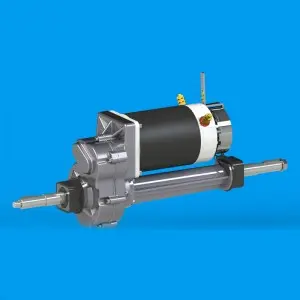Are you a car enthusiast or just curious about how cars work? If so, you may have come across the terms “differential” and “transaxle” in your research. Although these two components look similar, they serve different purposes in a vehicle’s driveline. In this blog, we’ll take a closer look at the differences between differentials and transaxles, and how they contribute to a car’s performance and functionality.
Let’s first understand what each component is and how it works.
differential:
The differential is an important part of a car’s transmission system, especially a rear-wheel drive or all-wheel drive vehicle. Its main function is to distribute the engine’s power to the wheels while allowing them to rotate at different speeds. This is crucial because when the car turns, the inner and outer wheels travel different distances and need to rotate at different speeds. A differential does this by providing a gear mechanism to compensate for differences in wheel speeds, ensuring the drivetrain operates smoothly and efficiently.
Transaxle:
A transaxle, on the other hand, combines the functions of the transmission and differential into one integrated unit. It is commonly found in front-wheel drive vehicles, where the transmission and differential are mounted in a single housing. The main function of the transaxle is to transmit power from the engine to the drive wheels and distribute this power to the wheels through the differential mechanism. By integrating these components, the transaxle helps save weight and space and provides better handling and weight distribution for front-wheel drive vehicles.
Now that we have a basic understanding of what a differential and transaxle are, let’s delve into the main differences between the two.
Design and placement:
One of the most obvious differences between differentials and transaxles is their design and placement within the vehicle. The differential is usually located on the rear axle of rear-wheel drive and all-wheel drive cars, or on the front and rear axles of some all-wheel drive vehicles. In contrast, a transaxle is located at the front of a front-wheel drive car and integrates the transmission, differential and axle into a single unit. This positional difference results directly from the vehicle’s drivetrain configuration and affects the car’s overall performance and handling characteristics.
Function:
Another important difference between a differential and a transaxle is their respective functions. The differential is only responsible for managing differences in wheel speed during cornering and ensuring that power is evenly distributed to the drive wheels. They play no role in directly providing gear ratios or converting engine power into rotational force. In contrast, a transaxle performs the dual functions of transmission and differential. Not only do they transmit power from the engine to the wheels, they also provide shifting capabilities through different transmission ratios to optimize engine output and fuel efficiency.
Maintenance and repair:
Differentials and transaxles have their own set of considerations when it comes to maintenance and repair. Differentials, especially those in rear-wheel or all-wheel drive vehicles, require regular maintenance, including changing fluids and inspecting gear components. In the event of damage or wear, differential components may need to be replaced, but overall maintenance is relatively simple.
However, transaxles are more complex units containing transmission and differential components. This means maintenance and repairs can be more complex and costly. In addition to regular transmission maintenance, the transaxle may require special attention to its differential gears and components. Repairing or replacing transaxle components may also be more labor intensive due to their integrated nature, which may require additional time and expertise.
Performance and handling:
The differences between differentials and transaxles also affect a vehicle’s performance and handling characteristics. Differentials, especially those in rear-wheel-drive sports cars and all-wheel-drive vehicles, provide better traction and stability by allowing the wheels to rotate independently. This promotes smoother cornering and more balanced power delivery, enhancing driving dynamics and performance.
Transaxles, on the other hand, offer advantages to front-wheel drive vehicles by integrating the transmission and differential into a single unit. This results in improved weight distribution, better front-to-rear balance, and more efficient power transfer, ultimately enhancing handling and stability. While transaxles may not offer as much customization or performance tuning as differentials, they play a vital role in optimizing the daily driving and maneuverability of a front-wheel-drive car.
In summary, the differences between differentials and transaxles are their design, function, maintenance requirements, and impact on vehicle performance and handling. Differentials manage wheel speed differentials and power distribution in rear-wheel and all-wheel drive vehicles, while the transaxle combines the transmission and differential functions in front-wheel drive vehicles. Understanding these differences is critical for car enthusiasts, mechanics, and anyone interested in gaining a deeper understanding of the complex workings of a vehicle’s drivetrain. Whether you’re considering upgrade options for your car or just want to expand your knowledge, understanding the difference between a differential and a transaxle can help you make informed decisions and better appreciate the power of our The engineering marvel that powers the vehicle. Thank you for reading! Have a nice day!
Post time: Mar-01-2024


